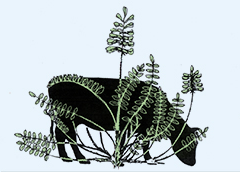Abstract
Hard yellow liver disease or fatty cirrhosis periodically affects cattle, sheep, goats, pronghorn antelope (Antilocapra americana) and whitetail deer (Odocoileus virginianus texanus) within several Texas counties in the United States. Clinically it presents as chronic liver disease with progressive hepatic necrosis and fibrosis, icterus and liver failure. The damaged livers are yellow and many have multiple firm, often gritty foci that are scattered throughout all lobes. Early investigations included feeding studies using potential toxic plants, climate and forage studies, infectious disease surveys and various mycotoxin studies and analyses. None have definitively reproduced the disease or identified the inciting cause. However, the problem continues and recent outbreaks have allowed the collection of additional frozen tissues, and numerous paraffin tissue blocks and slides for additional studies. The objectives for this work are to evaluate and compare the microscopic changes, special histochemical studies, microbial and fungal surveys and chemical assays for dehyro-pyrrolizidine alkaloid (DHPA) metabolites of these additional cases with historical reports. These bovine livers had a spectrum of lesions including lipid degeneration and necrosis, eosinophilic granulomatous hepatitis, focal follicular lymphoid proliferation and chronic fibrosing hepatitis with dystrophic mineralization. No pyrrolizidine alkaloid metabolites were detected in any of the livers and select special stains did not reveal any fungal, bacterial or parasitic etiologies. The lack of findings and mixed histologic presentation suggest that this syndrome is a collection of chronic diseases probably of various etiologies. Earlier animal surveillance work is needed in endemic areas to better understand the etiology and pathogenesis of this syndrome.
Recommended Citation
Stegelmeier, Bryan L.; Jones, Meredyth; Womack, Christopher P.; Davis, T Zane; and Gardner, Dale R.
(2019)
"North American Hard Yellow Liver Disease: An Old Problem Readdressed,"
Poisonous Plant Research (PPR): Vol. 2, p. 1-13.
DOI: https://doi.org/10.26077/6ksg-1685
Available at:
https://digitalcommons.usu.edu/poisonousplantresearch/vol2/iss1/1
Included in
Large or Food Animal and Equine Medicine Commons, Veterinary Pathology and Pathobiology Commons, Veterinary Toxicology and Pharmacology Commons

